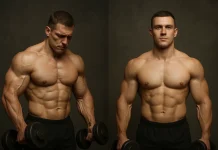Last Updated on January 22, 2024
We have all seen health club regulars who never miss a day of working out yet never seem to make any improvements in their bodies.
Fortunately, the problem may be simple to fix. Take a look around the gym. See the man peddling away slowly on the exercise bike while reading a magazine? The woman chatting on her cell phone while attempting leg curls? They are all guilty of sabotaging their workouts – sometimes by transferring couch-potato habits to the gym, other times by not being smart about workout choices.
“It’s a universal problem,” says personal trainer Dr. Bruce Nadler, a former New York City plastic surgeon and author of The Nip Tuck Workout. “Many people don’t realize it’s called a workout because you have to work for it.”
Showing up at the gym is a start – many people with gym memberships never use them at all. But if you want serious results like sculpted biceps, a trimmer tummy or dramatic weight loss, it’s not enough. According to Nadler, in order to get in a particular shape and maintain it, a person should work out at least three to five days per week, combining strength and cardio training for about an hour each visit.
In order to lose weight – say, half a kilo a week – a person must decrease their daily caloric intake by 500. Reducing the number of calories ingested is one way, but it helps to combine diet with expending calories through exercise. To maximize the calories burned during cardio work, Nadler says the body must become hyperthermic – a process that slightly raises the core temperature and works as a catalyst to burn fat. That means sweating is encouraged (created by exertion – not by a sauna). Otherwise, you’re not working hard enough.
When strength training, the concept changes a little. The goal is to break down muscle tissue so that it can rebuild itself. This doesn’t happen unless the muscles are constantly challenged by increasing the number of repetitions, weight, or the order of the exercise. The key is to feel fatigued by the last repetition – to the point that it seems almost impossible to finish. But that doesn’t mean the full set should feel uncomfortable. Having weight that is too heavy can cause poor form and injury.
The whole point is not to reach a plateau. Once your body is no longer feeling challenged, it is time to change the workout. Otherwise, the progress you make in the beginning will eventually come to a halt.
“By far the number one reason people stop seeing results is due to adaptation,” says Jason Pulido, national director of personal training for Crunch Fitness, a chain of fitness gyms in California and New York. “When someone tries a workout and sees results, they will continue to do that same workout over and over.”







